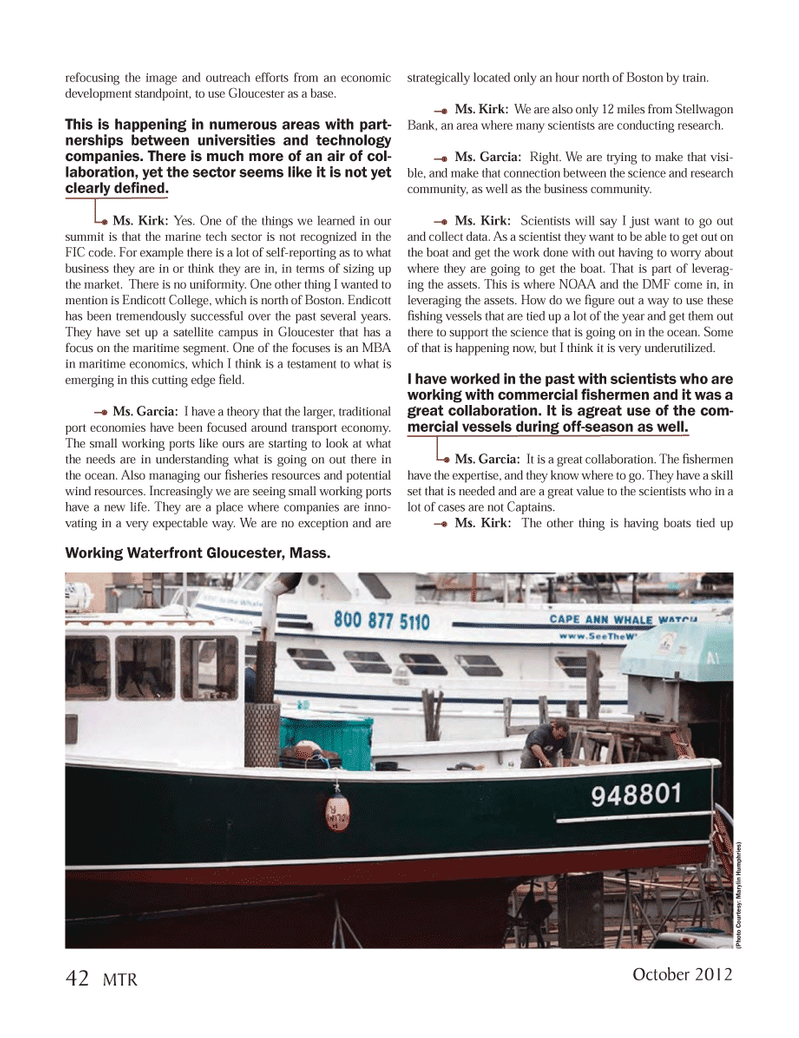
Page 42: of Marine Technology Magazine (October 2012)
Ocean Observation: Gliders, buoys & sub surface monitoring networks
Read this page in Pdf, Flash or Html5 edition of October 2012 Marine Technology Magazine
refocusing the image and outreach efforts from an economic development standpoint, to use Gloucester as a base. This is happening in numerous areas with part- nerships between universities and technology companies. There is much more of an air of col- laboration, yet the sector seems like it is not yet clearly deÞ ned. Ms. Kirk: Yes. One of the things we learned in our summit is that the marine tech sector is not recognized in the FIC code. For example there is a lot of self-reporting as to what business they are in or think they are in, in terms of sizing up the market. There is no uniformity. One other thing I wanted to mention is Endicott College, which is north of Boston. Endicott has been tremendously successful over the past several years. They have set up a satellite campus in Gloucester that has a focus on the maritime segment. One of the focuses is an MBA in maritime economics, which I think is a testament to what is emerging in this cutting edge Þ eld. Ms. Garcia: I have a theory that the larger, traditional port economies have been focused around transport economy. The small working ports like ours are starting to look at what the needs are in understanding what is going on out there in the ocean. Also managing our Þ sheries resources and potential wind resources. Increasingly we are seeing small working ports have a new life. They are a place where companies are inno- vating in a very expectable way. We are no exception and are strategically located only an hour north of Boston by train. Ms. Kirk: We are also only 12 miles from Stellwagon Bank, an area where many scientists are conducting research. Ms. Garcia: Right. We are trying to make that visi- ble, and make that connection between the science and research community, as well as the business community. Ms. Kirk: Scientists will say I just want to go out and collect data. As a scientist they want to be able to get out on the boat and get the work done with out having to worry about where they are going to get the boat. That is part of leverag- ing the assets. This is where NOAA and the DMF come in, in leveraging the assets. How do we Þ gure out a way to use these Þ shing vessels that are tied up a lot of the year and get them out there to support the science that is going on in the ocean. Some of that is happening now, but I think it is very underutilized. I have worked in the past with scientists who are working with commercial Þ shermen and it was a great collaboration. It is agreat use of the com-mercial vessels during off-season as well. Ms. Garcia: It is a great collaboration. The Þ shermen have the expertise, and they know where to go. They have a skill set that is needed and are a great value to the scientists who in a lot of cases are not Captains. Ms. Kirk: The other thing is having boats tied up Working Waterfront Gloucester, Mass. (Photo Courtesy: Marylin Humphries) October 201242 MTRMTR #8 (34-49).indd 42MTR #8 (34-49).indd 4210/22/2012 9:03:28 AM10/22/2012 9:03:28 AM

 41
41

 43
43
